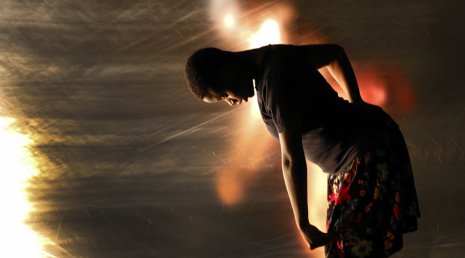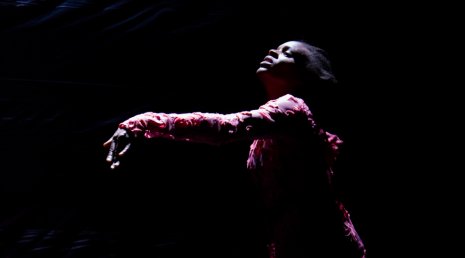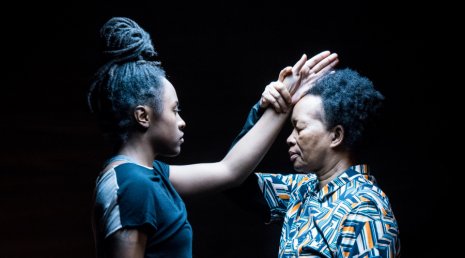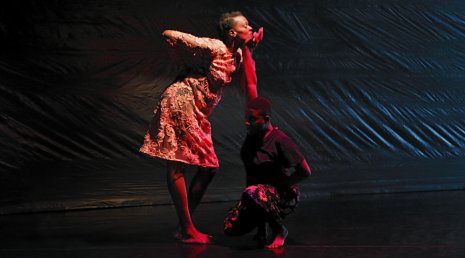Chapter Two
I’m not sure, that I even really answered your last question….
The performer’s body as the “imaginer” for the “unimagined" or the “unimaginable.” The body is perhaps the ultimate transmitter, if we will let it be. As humans, I believe we’re primed to do a kind of projectile jump into the bodies that we watch. (Perhaps there are all sorts of ways that we’re trained to get in the way of that process of jumping into the skin of another, when we’ve been acculturated to dehumanize others because of their gender, race, religion, country of origin.) But setting up a performance space for me and my long time collaborator, Peter Born, is about priming the space for that jump.
Peter is the director and designer of the space. So, I give him room to be a fully-embodied watcher. We have a number of conversations about an idea before we enter a studio. That way, when it is time to enter, Peter will have already started thinking about the shape of the space, and he will bring in materials-- scraps of mirror-like mylar, plastic sheets, clip lights--and I will begin to dance with those materials.
And he dances as much as he watches, physically moving lights around the space, considering where the shadows might emerge and where the shadows might dance. I am lucky to have Peter as both an outside eye and an inside eye working with me to constantly reflect on how the body of the person watching/witnessing the work might encounter the space. Our rehearsal process becomes a series of transmissions between us where we can jump into and out of each other.
I think we have everything to offer, and it feels as if everything is at stake right now. How do we continue to make space for the complex renderings/writings of our limbs? How do we resist staying in our place, as dictated by forms that had no place for us? Dancing is to stake an empathic presence. Maybe this is too much of a generalization, but we seem to live in a culture that wants to look at “prepared” bodies. We are increasingly silo-ed behind computer screens, or the disembodied avatars of our social media personas that we’ve shaped into some odd perfection. What to do when we encounter a body that refuses any easy reading? What to do when we encounter a body that refuses to do what we think it should be doing and confounds us in every second--and not because your leg can go over your head or your pirouettes come by the dozens, but because there is some tiny gesture that is so full of aching or longing or perhaps completely barren of any of that, and you cannot be certain that you are grasping any of it, but you are held somehow? So, do we offer our bodies, not just as tools to express virtuosity but as sites for the rigorous exploration of being undone and becoming over and over and over again because we are alive in each second, differently than the second before—on some altar where we might be empowered and humiliated, but we are living?
Everyone should be moving as much as possible. Nod your head, sprawl on the ground, open your mouth to the sun and arch your back, breathe.
Maybe it’s a matter of possession; possessing myself and being possessed.
Yes, I do feel as if we’re in the midst of a cosmic eruption—thrust out of orbit, hurtling towards the irresistible center of a black hole. Or are we already in it, already contorted and compressed beyond recognition? Who are we now?
Or maybe I should consider the nature of the orbit we are being thrust out of. Maybe we are being thrust out of the schoolbook fantasy that this is a nation founded on the fundamental belief in equality and the right to the pursuit of life, liberty and happiness. Maybe we are being forcefully awakened out of the fantasy of the United States of America as a nation imploring the world to send their homeless, tired and poor, and the “wretched refuse of your teeming shore.” Maybe we were never anchored to the shining star we laid claim to. Maybe we are all finally unearthing the bones that lay buried in the foundation of this experiment that is the United States.
Of course, I believed this country held out a promise that--in spite of the wreckage of slavery, in spite of the theft and genocidal acts against the indigenous populations, in spite of the Japanese internment camps, in spite of all of the people initially disenfranchised--that the laws written at the founding of this country would make restitution to these many people inevitable. One would think that enough blood had been shed, that enough bones had been broken, enough minds had been enlightened. But I find solace in the pragmatic streak running through the outrage of this time, people are organizing, refusing to be silent, they are resisting, they are mattering, they are insisting on the fulfillment of the promise.
As artists, we are not only insisting on the promise, but we are imagining and building spaces on the very foundation of that promise. I see signs of hope in your Long Table Discussions, in Dancing While Black, in the Urban Bush Women Institute, in artists mobilizing to bring a multiplicity of voices and practices from the margins to the center and, in all of this, refusing to cede ground that has been hard won.
******
Eva Yaa Asantewaa (2017 Bessie Award winner for Outstanding Service to the Field of Dance) is an arts writer, curator and community educator. She has been published since 1976 and, since 2007, has blogged at InfiniteBody. Ms. Yaa Asantewaa curated the skeleton architecture, or the future of our worlds, an evening of group improvisation featuring 21 Black women and gender-nonconforming performers for Danspace Project’s Platform 2016: Lost and Found. Her cast won a 2017 Bessie for Outstanding Performer.





